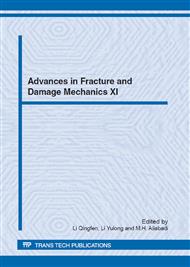p.573
p.577
p.581
p.585
p.589
p.593
p.597
p.601
p.605
Two Scale-Based Continuum Damage Model for Brittle Materials under Thermomechanical Loading
Abstract:
Ceramic refractory materials initially contain a multitude of defects such as voids, microcracks, grain boundaries etc. Particularly being exposed to high temperatures above 1000 °C the macroscopic properties such as effective compliance, strength and lifetime are essentially determined by microscopic features of the material. The deformation process and failure mechanisms are going along with the creation of new microdefects as well as the growth and coalescence of cracks. A brittle material damage model for dynamic thermomechanical loading conditions is presented in this paper. Representative volume elements (RVE) include microcrack initiation and growth. The material laws are formulated on the continuum level using appropriate homogenisation methods. To demonstrate the potential of the numerical tools, two examples are presented which are taken from applications. Based on experiments, cyclic thermal shock tests at refractory plates are simulated by FEM. To quantify the thermal shock resistance of ceramics, experiments suggested by Hasselman are simulated numerically supplying a critical temperature slope.
Info:
Periodical:
Pages:
589-592
Citation:
Online since:
November 2012
Authors:
Keywords:
Price:
Сopyright:
© 2013 Trans Tech Publications Ltd. All Rights Reserved
Share:
Citation:


